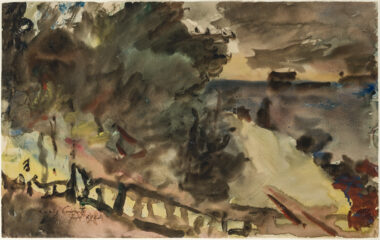Corinth, Lovis
Sold Artworks
Biography
Lovis Corinth
1858 Tapiau – 1925 Zandvoort
With Max Liebermann and Max Slevogt, Lovis Corinth came to be recognized as one of Germany’s three leading exponents of Impressionism. The term ‘Impressionist’ fails, however, to adequately define the multifaceted spectrum of Corinth’s oeuvre. From traditional academic beginnings he would go on to develop, over the course of a fifty-year career, a style of painting that in its expressive use of form and colour was far ahead of its time, placing him in the vanguard of modernism.
The son of a wealthy tanner, Corinth grew up in provincial East Prussia. With his propensity for bouts of self-doubt and depression, he was hardly predestined to a stellar artistic career. A first period of academic study in Königsberg was followed by a three-year training in painting at the Academy of Art in Munich from 1880 to 1883. He spent the years 1884 to 1887 in Paris, where he honed his skills at the Académie Julian, partly under the tutelage of the Salon painter William-Adolphe Bouguereau who taught him to paint the nude model. Bouguereau was one of the most sought-after French academic painters of the late nineteenth-century. Corinth did not aspire to reproduce the technical perfection of his teacher’s work but was nevertheless long guided by Bouguereau’s pictorial approach, particularly when addressing literary subjects. These compositions were usually large in format and rich in figures. In addition, he nurtured a strong interest in Dutch seventeenth-century painting, his avowed models being Frans Hals, Rembrandt and Rubens. At this stage in his career he had little awareness of the French Impressionists.
After eight years in Munich Corinth moved to Berlin in 1888. Here, he found in Max Klinger, Walter Leistikow and Karl Stauffer-Bern like-minded allies in the drive for modern artistic expression. But only three years later he was back in Munich, disillusioned by his lack of success. He began to frequent the city’s literary and artistic circles and in 1892 joined the Munich Secession. In the early 1890s the influence of plein-air tendencies marked his landscapes and to some extent also his portraits, nudes and interiors. In his portrayal of existential themes like love, sexuality and death he drew on subjects from Greek mythology, Christianity and classical literature. Departing from Old Master tradition he sought to create new, equally valid pictorial inventions. Many of the images he produced border on the burlesque and their directness tends towards exaggeration. They are sometimes dramatic and surprise to the point of absurdity. The perceived tastelessness and lack of dignity in Corinth’s paintings created major divisions among contemporary viewers and critics. This is one of the main reasons why Corinth was never fully accepted in Munich art circles.
The year 1900 marked a turning point in his career. When the Munich Secession rejected his painting Salome, on which he had pinned high hopes, his friend Walter Leistikow persuaded him to relocate to Berlin. Co-founder of the Berlin Secession in 1898, together with Max Liebermann and the gallerist Paul Cassirer, Leistikow actively promoted Corinth’s membership. He was also responsible for introducing Corinth to other influential figures in Berlin art circles. But it was largely thanks to the support of Leistikow, Liebermann and Cassirer that Corinth quickly took on a leading role within the city’s thriving artistic community.
In 1901, Corinth set up a private school of painting for women. One of his first pupils was his future wife, Charlotte Berend. As his pupil, model, muse and the mother of his children, she was to be his lifelong spiritual partner. Corinth played an increasingly important role in Berlin artistic life, first, as a committee member at the Berlin Secession and from 1911, as its chairman. The appointment marked the peak of his success. However, in December 1911 he suffered a stroke and was paralysed on one side. Psychologically changed by the shock of physical collapse and newly aware of his own fragility he was nevertheless able to draw on reserves of inner strength that released a surge of creative energy and a radically new painterly freedom.
Despite the burden of severe physical handicap Corinth went on to develop an expressive language of groundbreaking intensity that stripped away all trace of academic convention. In the last fifteen years of his life he discovered a new proximity to nature as his focus shifted towards landscapes and flower still lifes painted with lavish use of colour in a free, increasingly impulsive ductus.
In 1919, Corinth and his wife acquired a plot of land and oversaw the construction of a house in Urfeld on Lake Walchensee in the Upper Bavarian Alps. The house was to be a retreat, place of inspiration and refuge from the hectic day-to-day life of Berlin. The view of the Alps at different times of day and in different seasons and changing weather conditions inspired a large body of work. In these images of the lake and the surrounding landscape artistic experimentation is tested to its fullest. In their entirety, the drawings, watercolours and paintings appear as impressive variations on one and the same theme. But the topography itself merely serves as a vehicle to convey Corinth’s inner life and emotions. Much like the Seelenlandschaften of Romanticism the images become melancholic places of retreat and reflection into which his introspective self-analysis is projected – landscapes of his inner voice. Today, Corinth’s ‘Walchensee’ paintings are regarded as the high point of his late oeuvre. They underscore the importance of his position among the pioneers of modernism.
PDF Download